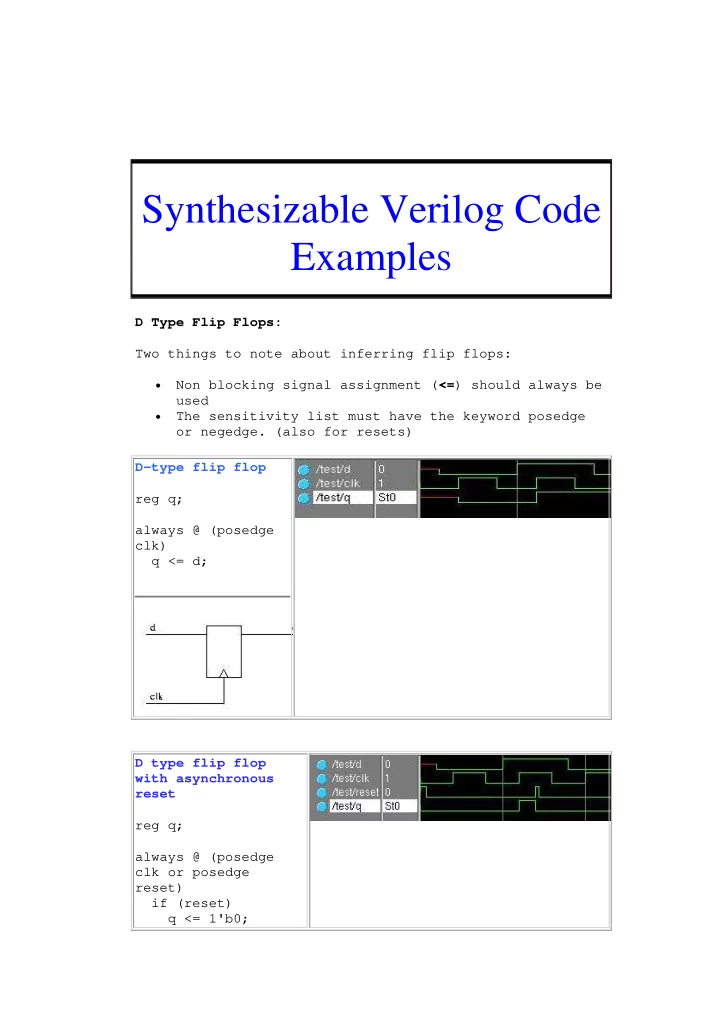

Synthesizable Verilog Code Examples Last update August 2000 D Type Flip Flops: Two things to note about inferring flip flops: � Non blocking signal assignment ( <= ) should always be used � The sensitivity list must have the keyword posedge or negedge. (also for resets) D-type flip flop reg q; always @ (posedge clk) q <= d; D type flip flop with asynchronous reset reg q; always @ (posedge clk or posedge reset) if (reset) q <= 1'b0;
else q <= d; D type flip flop with synchronous reset reg q; always @ (posedge clk) if (reset) q <= 1'b0; else q <= d; D type flip flop with gated clock reg q; wire gtd_clk = enable && clk; always @ (posedge
gtd_clk) q <= d; Data enbled D type flip flop reg q; always @ (posedge clk) if (enable) q <= d; Negative edge triggered D type flip flop reg q; always @ (negedge clk) q <= d;
Latches Latch reg q; always @ (q or enable) if (enable) q = d; Multiplexers Two input multiplexer (using if else) reg y; always @ (a or b or select) if (select) y = a; else y = b;
Two input multiplexer (using ternary operator ?:) wire t = (select ? a : b); Two input multiplexer (using case statement) reg w; // mux version 3 always @ (a or b or select) case (select) 1'b1 : w = a; default :
w = b; endcase Two input multiplexer (using default assignment and if) reg p; // mux version 4 always @ (a or b or select) begin p = b; if (select) p = a; end Three input priority encoded mux multiplexer (using if else) reg q;
always @ (a or b or c or select2) if (select2 == 2'b00) q = a; else if (select2 == 2'b01) q = b; else q = c; Three input priority encoded mux multiplexer (using case) reg r; // Priority encoded mux, version 2 always @ (a or b or c or select2) begin r = c; case (select2) 2'b00: r = a; 2'b01: r = b; endcase end
Three input multiplexer with no priority (using case) reg s; always @ (a or b or c or select2) begin case (select2) // synopsys parallel_cas e 2'b00: s = a; 2'b01: s = b; default: s = c; endcase end
Comparator (using assign) module comparator1 (a,b,c); input a; input b; output c; assign c = (a == b); endmodule Comparator (using always) module comparator2 (a,b,c); input a; input b; output c; reg c; always @ (a or b) if (a == b) c = 1'b1; else c = 1'b0; endmodule
Finite State Machines A full example of a state machine and associated test bench The state machine The following is a simple for state finite state machine. The methodology for writing finite state machines is as follows: 1. Draw a state diagram. Label all conditions, label all output values. Label the state encoding. 2. Use parameter to encode the states as in the example. 3. Use two processes or always statements- one sequential and one combinational. See the example. 4. The state machine is normally resettable _ choose synchronous or asynchronous. 5. The combinational process normally has one big case statement in it. Put default values at the beginning. There are a couple of neat things about the example. We are using parameters is the test bench and passing them to the state machine using parameter passing We are using tasks to control the flow of the testbench We are using hierarchical naming to access the state variable in the state machine from the test bench. Finally we are using test bench messages which allow us to monitor the current state from the simulation waveform viewer (assuming we change the bus radix of the 'message' to ascii. // -------------------------------------------- // // S T A T E M A C H I N E //
// -------------------------------------------- module state_machine(sm_in,sm_clock,reset,sm_out); parameter idle = 2'b00; parameter read = 2'b01; parameter write = 2'b11; parameter wait = 2'b10; input sm_clock; input reset; input sm_in; output sm_out; reg [1:0] current_state, next_state; always @ (posedge sm_clock) begin if (reset == 1'b1) current_state <= 2'b00; else current_state <= next_state; end always @ (current_state or sm_in) begin // default values sm_out = 1'b1; next_state = current_state; case (current_state) idle: sm_out = 1'b0; if (sm_in) next_state = 2'b11; write: sm_out = 1'b0; if (sm_in == 1'b0) next_state = 2'b10; read: if (sm_in == 1'b1) next_state = 2'b01; wait: if (sm_in == 1'b1) next_state = 2'b00; endcase end endmodule
Recommend
More recommend